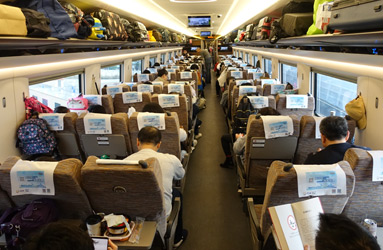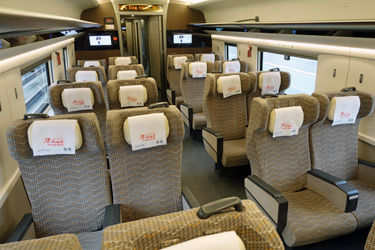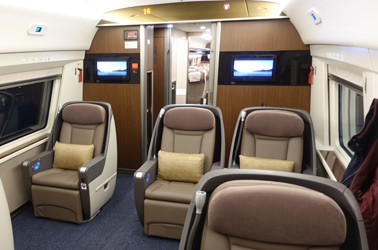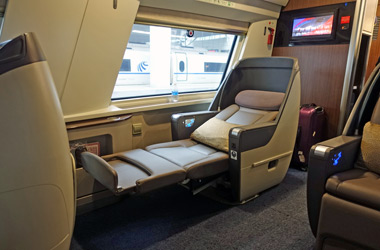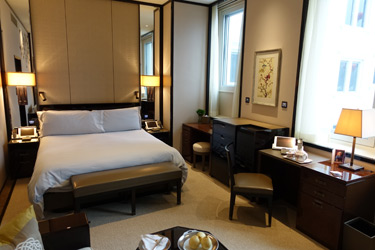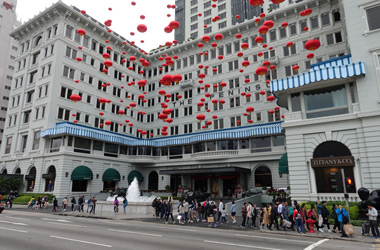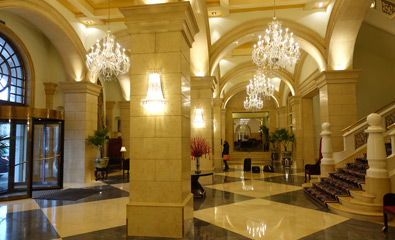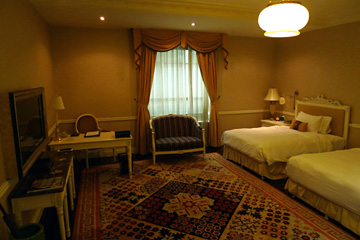 |
|
|
Bullet to Beijing: Hong Kong West Kowloon to Beijing by high-speed train at up to 300 km/h (186 mph). Full details of how to buy tickets. For other Chinese train routes & a beginner's guide to train travel in China, see the Train Travel in China page. |
Kowloon to Beijing: 1,516 miles in 8h56
The Hong Kong high-speed rail link opened on 23 September 2018 and it's now possible to travel between Hong Kong & Beijing in a day. A daily bullet-nosed Fuxing train originally covered the 2,441 km (1,516 miles) in a remarkable 8h56, an average speed of 168 mph including 6 stops. From 15 June 2024, maximum speed is increased to 350 km/h and journey time cut to 8h10, an average speed of 185 mph.
You experience China's impressive new high-speed rail network while you take in the scenery, catch up on your reading and enjoy a beer or two from the bar car. The high-speed rail link from Hong Kong to China is jointly operated by Chinese Railways Guangzhou division and MTR (the Hong Kong transit company), although the train to Beijing is run by the Chinese.
![]() Boarding at Hong Kong West Kowloon
Boarding at Hong Kong West Kowloon
![]() What is the high-speed
train like?
What is the high-speed
train like?
![]() Travel tips: Luggage, food & drink, WiFi
Travel tips: Luggage, food & drink, WiFi
![]() Video guide: Hong Kong to Beijing by
train
Video guide: Hong Kong to Beijing by
train
![]() Other train & ferry services from Hong Kong
Other train & ferry services from Hong Kong
Train times northbound
In Hong Kong, the station is Hong Kong West Kowloon Terminus, the new high-speed train terminal which opened in 2018. See map of Hong Kong showing station location. You should arrive at least 45 minutes before the train leaves to complete Hong Kong & mainland China border formalities.
Border formalities when leaving Hong Kong: Hong Kong & Chinese border formalities take place at Hong Kong West Kowloon station before you board the train. I would arrive at the station at least 60 minutes before your train, although I found we were through formalities and waiting in the departure lounge a mere 15 minutes after entering the station, it will take longer at busy times! On arrival in Beijing there are no further formalities, you just walk out of the station.
Train times southbound
In Beijing the station is Beijing West (Beijing Xi in Chinese), see map of Beijing showing stations. You should arrive at the station in good time (perhaps 20-30 minutes before departure) as there's a baggage X-ray check when entering the station, but there is no check-in as such.
Border formalities when travelling towards Hong Kong: There are no formalities to go through before boarding the train in Beijing, other than the usual ticket check and X-ray baggage scan which you should expect when entering any Chinese station, whether mainline or metro. Beijing West is a big place so don't cut it fine, but turning up 20-30 minutes before your train is sufficient. Hong Kong & Chinese border formalities take place at Hong Kong West Kowloon station after the train arrives. You take the lifts or escalators from the platform on Level B4 up to Level B2 where you go through mainland China passport control, mainland China customs (another X-ray bag check!) and then Hong Kong passport control. It took me just 25 minutes to pass through Chinese exit & Hong Kong entry formalities from the time my train arrived to the time I walked out of Hong Kong West Kowloon station into Austin MTR metro station, although at very busy times it could take up to an hour.
How much does it cost?
Since January 2023, children under 6 travel free (just one per adult goes free), all other children under 14 travel for half fare. Those 14 & over pay full fare.
How to buy tickets
-
Option 1, buy tickets in either direction at www.chinahighlights.com, a reliable agency that I can recommend.
This can book all classes including business class. You are emailed an e-ticket for your mobile phone with which you can board the train.
-
Option 2, buy tickets in either direction at 12go.asia, another reliable booking agency.
They can book 1st or 2nd class, but not always business class. Confirmation is instant. You're emailed an e-ticket for your phone and can board the train.
-
Option 3, buy tickets at www.klook.com, another well-known online agency.
They can book 1st, 2nd class or business class with instant confirmation. You're emailed an e-ticket for your phone and can board the train.
Alternatively, take a sleeper between Hong Kong & Beijing
On Friday, Saturday, Sunday & Monday nights you can also travel from Hong Kong to Beijing by high-speed sleeper train, see the Train travel from Hong Kong page.
Hong Kong West Kowloon station
If you arrive on foot, you enter at ground level (Level G). Most of the station is underground.
Ticketing & departures concourse
One floor down from ground level is Level B1, the Ticketing & Departures Concourse. If you arrive by taxi, there's a taxi drop-off at this level. If you arrive by metro at Austin MTR station, follow the signs from the metro ticket hall through a short pedestrian tunnel sloping gently upwards directly into this level. Levels G, B1 & B2 curve around a vast atrium, the photo below is taken from Level B1.
On Level B1 you'll find the ticket counters, the entrance to departures, ticket machines, shops & cafes. The level below, B2, is for arrivals. The seats you can see at the bottom of the atrium are the departure lounge on Level B3 where you wait for your train to board. The platforms & trains are underground on level B4.
Ticket collection
On the Ticketing & Departures Concourse Level B1 there is a row of 28 ticket counters, see the photo below. Window 1 is on the left, window 28 is on the right. All ticket counters are clearly marked with their purpose, with an efficient queuing line. It can easily change, but at the time of writing:
-
Counters 1-5 are for sale of mainland China tickets. If you wanted to buy a ticket from Guangzhou to Beijing, go here.
-
Counters 6-10 are for collection of mainland China tickets, including tickets from Hong Kong to China booked via the Chinese Railways ticketing system. If you booked via an agency who used the Chinese ticketing system, you'd collect tickets here.
-
Counters 11-20 are for ticket sales from Hong Kong to or from China. These windows will use the MTR ticketing system.
-
Counters 21-25 are for collection of tickets booked through the MTR ticketing system, either on the MTR High-Speed Rail website or if you booked through an agency who sourced your tickets from the MTR system.
-
Counters 26 & 27 are for ticket alterations, refunds, lost tickets, meaning tickets bought through the MTR system.
-
Counter 28 is marked priority and has a lower wheelchair-accessible counter for all purposes.
On this quiet February day (even at the tail end of the Chinese Spring Holiday) there were no queues at these counters and collecting tickets only took a minute or two. But it may be busier in summer or at peak holiday times, feedback is always appreciated.
Ignore the self-service ticket machines, meaning both the many MTR machines and the machines signed 12306.cn (the name of the Chinese Railways official website). These only work for sales or collection if you have a Hong Kong or Mainland China ID card, which most visitors won't. You will need to go to a staffed counter.
Customs & immigration on departure from Hong Kong
You should get to the station for boarding at least 45 minutes before the departure of your train.
The entrance to departures is clearly marked on Level B1, see the photo below - if I swung the camera to the left you'd see the ticketing counters. The atrium is behind me. At the entrance a member of staff checks you have a valid ticket, then a few metres further on you put your ticket through an automatic ticket gate.
You then put your bags through an X-ray baggage scan and walk through the metal detector. It's much quicker than at an airport, there's no fumbling with laptops or large plastic boxes, no removal of belts or shoes, you literally just place your bag directly on the conveyor and pick it up on the other side, it takes a minute or two.
You now descend the escalators or use the lifts to Level B3.
On Level B3 you first go through the Hong Kong passport check. There are automatic passport gates, these worked just fine with a UK passport.
You then walk on over the broad yellow line on the floor marking where Hong Kong authority changes to mainland China.
Now comes the mainland China passport check. There are one or two separate counters for foreigner visitors. On this February day there was no queue, I was through in a minute or two once my passport had been checked and my face and fingerprints scanned and confirmed.
Immediately after the mainland China passport check there's yet another baggage X-ray, this time for mainland China customs.
You emerge into the departure lounge with plenty of seating in the bottom of the vast atrium, see the photo below. On this occasion the whole process took 15 minutes from entering Departures on Level B1 to sitting in the departure lounge on Level B4, but it can take longer at busy times.
Business lounge
If you have a business class ticket you can use the business lounge. This means going up one level by lift to Level B2, but it's clearly marked. Your ticket is checked at the reception desk. The lounge is spacious but rather empty, those windows overlook the main departure lounge below. I was offered a nice cup of Chinese tea, but there are few other benefits. You return to level B3 when boarding starts...
Boarding the train
Your ticket may show the boarding gate number at top right, mine showed Gate 7B. The gates are located at either end of the departure lounge, all clearly signed. The platforms are numbered 4 to 18. Platforms 4-9 are long enough to take 16-car trains, platforms 10-18 only long enough for 8-car trains. The 'A' gates are at the southern end of each platform, for boarding 8-car trains or the rear 8 cars of a 16-car train. The 'B' gates are at the northern end of platforms 4-9 for boarding the front 8 cars of a 16-car train.
Boarding starts 10-20 minutes before departure. Your ticket is checked at the gate, either by staff or by putting it through an automatic gate. You then go down an escalator or in a lift to the platform on Level B4.
What is the high-speed train like?
The G80 and it's southbound equivalent the G79 are operated by 16-car CR400AF Fuxing (revival) high-speed trains. These are the world's fastest passenger trains, designed for up to 400 km/h and operating in service at up to 350 km/h (217 mph), although you're unlikely to exceed 300 km/h (186 mph) on this route. The train has 2nd class, 1st class & business class plus a small cafe counter selling Chinese tea, coffee, beer, snacks & microwaved hot dishes. Unlike some other Chinese high-speed trains there are no sit-down cafe tables, just the serving counter.
Business class seats are arranged 2+1 across the car width, except for the pair of seats immediately behind the driving cab at each end of the train where the train body tapers, where seats are 1+1 across the car width. On this 16-car CR400AF-A train, the whole of car 1 is business class, and there's also a small 5-seat business class area at other end of the train in car 16, seen here. Car 1 is normally at the rear & car 16 at the front when going north to Beijing, car 1 at the front & car 16 at the rear when heading south to Hong Kong. The seats recline electrically and become a flat bed at the touch of a button, a blanket & cushion are supplied. Each seat has a power socket. The fare includes one hot tray meal (pictured below right) and a steady stream of Chinese tea, coffee, apple juice, orange juice or soft drinks. You'll also get a complimentary box of strange Chinese biscuits & sweets. There's a VIP lounge for business class passengers at Beijing West & Hong Kong West Kowloon. Business class is expensive even by western standards, but if you can stretch that far it's well worth it. Click the images for larger photos...
Update June 2024: The latest type of Fuxing train is being deployed on this route from 15 June 2024, with business class 'suites' where the flatbed seat is enclosed by low-height walls and sliding door, like some first class suites on long haul airliners.
What's the journey like?
This is a 1,516 mile journey right across China, exclusively using China's massive and expanding high-speed rail network. The impressive scale of this network and of the vast high-speed rail stations in these cities needs to be seen to be appreciated...
The first part from Hong Kong West Kowloon to the Chinese border is underground, with speed limited to 200 km/h. The train emerges into daylight at the border and soon afterwards calls at the massive new Shenzhenbei (Shenzhen North) station, pictured above.
Once in China the train keeps up a steady 300 km/h (186 mph), stopping at 6 major cities between Kowloon & Beijing for just a few minutes each.
You really get a feel for how fast China is developing.
Just 50 minutes after leaving Kowloon - a 2 hour journey by classic train - the G80 arrives into Guangzhou's enormous South station.
After Guangzhou you'll see plenty of rural valleys and rice fields in southern China - although it somehow never becomes as deeply rural as you might expect.
With a succession of valleys and tunnels, this is perhaps the most scenic part of the trip.
...on this February day the hills were shrouded in mist.
Villages, towns, industry, endless half-finished construction sites.
The train calls at Changsha South station, with another CR400A Fuxing on the other side of the platform.
In contrast to the hills & valleys down south, you'll now see mile after mile of flatlands further north towards Beijing. In many fields you'll see one or more strange piles of stones looking like graves - which is exactly what they are. Traditional field graves can be seen dotted across rural China, which can't make ploughing or planting any easier.
Entering Beijing West station, with a classic green-and-yellow sleeper train leaving from a far track.
Arrival at Beijing
There are no formalities to go through on arrival at Beijing West (Beijing Xi in Chinese) as these were all done in Hong Kong. Just remember to keep your ticket as you need to leave the station through automatic ticket gates. Also be prepared for yet another baggage X-ray at the entrance to the metro - but you'll soon get used to this in China!
Travel tips: Luggage, food, power sockets...
-
Car & seat numbering
This is a 16-car train. When travelling north towards Beijing, car 1 is usually at the rear & car 16 at the front. When heading south to Hong Kong, car 1 is usually at the front & car 16 at the rear.
Seats are numbered with a row number then a seat letter, like on a plane. In 2nd class where seats are 3+2 across the car width the seat letters are ABC-aisle-DF. In 1st class with 2+2 seating the seat letters are AC-aisle-DF. In business class the seat letters are AC-aisle-F except for the pair of seats behind the driver's cab at each end of the train which are lettered A-aisle-F.
So in all classes, A & F are always window seats. C & D are always aisle seats. B is the undesirable middle seat of three in 2nd class.
-
Luggage allowance
The luggage limit on Chinese trains is 20 Kg for adults & 10 Kg for children, and the maximum dimension of any item should not exceed 130cm on these G-category trains. However, in practice no-one weighs or measures your bags, as long as they comfortably fit through the security X-ray machines and you can carry them onto the train, you'll be fine. If you really want to transport vast quantities of luggage you can pay for a baggage ticket for bags in excess of the official limits.
You take your bags with you onto the train and put them on the luggage racks either above your seat or (larger items) at the car ends, just as on any European train. Bags are X-rayed before entering the station (Beijing) or as part of the departures process (Hong Kong).
-
Food & drink
You can take food & drink with you, or buy simple microwaved tray meals, snacks & drinks (including beer) from the buffet counter located in car 9. The buffet accepts RMB but not HK$. Have some cash with you, don't reckon on it accepting cards.
Business class tickets include a hot tray meal and a steady flow of complimentary tea, coffee & soft drinks plus a 'welcome box' of various Chinese sweets.
There's a boiling water dispenser in each car - ideal for making noodles, tea or coffee if you bring the necessary materials along!
Important tip: When leaving Hong Kong West Kowloon station, stock up with food & drink on Level B1 before entering departures. At present there are no cafes or shops in the departure lounge.
-
Power sockets & WiFi
There are power sockets at all seats, 220v, Chinese plug type, and a USB port. In theory there's free WiFi on board but this requires a code to be sent to a Chinese mobile phone so foreign visitors cannot use it. Just sign up for a mobile data package from your phone provider, there is good 3G/4G reception along most of this route. Using mobile data on a foreign SIM card gets around China blocking access to Google, Facebook, Twitter and so on, but you might want to pay for a VPN to get around these restrictions when using WiFi, see more information here.
-
Toilets & baby-changing facilities
There are both squat and western-style toilets in each car, very clean, with soap and toilet paper. There are baby-changing facilities in certain cars. The train also has at least one wheelchair-accessible toilet.
-
Language
All the departure screens, signage and so on is in English as well as Chinese. The system is remarkably organised and easy to navigate.
-
On-time performance
China's high-speed trains are far more punctual than it's domestic flights. Flights are notorious for delays, allegedly at least 45-60 minutes delay is typical. The high-speed trains generally run on time although we came to an unscheduled stop in central China so arrived 17 minutes late.
Video guide: Hong Kong to Beijing by train
Suggested hotels
In Hong Kong: The Peninsula Hotel, check prices
The oldest and most famous hotel in Hong Kong is undoubtedly the venerable 5-star Peninsula Hotel, opened in 1928. Used as HQ by the Japanese in WW2, it was in this hotel that the governor of Hong Kong surrendered to Japanese forces on 25 December 1941. For more about the history of the hotel see en.wikipedia.org/wiki/The_Peninsula_Hong_Kong. The Peninsula charges 5-star prices and might be outside many travellers' budget, but afternoon tea in the grand lobby has become something of an institution and costs rather less than a room! The hotel is located in Kowloon, 5 minutes walk from the Star Ferry terminal, one stop on the MTR metro from Austin (for Hong Kong West Kowloon High Speed Rail Terminal) and 17 minutes walk from Hung Hom station. You also get superb views across Hong Kong Harbour from the huge glass viewing windows at the Felix bar & restaurant on the 28th floor of the tower at the rear, although at almost £10 for a beer it's not cheap. Check prices & book the Peninsula Hotel. Tip: Ask for a room in the original 1928 building at the front if history matters to you, as half the rooms are now in a modern tower at the rear opened in 1994, just visible in the background in the photo below right, rising above the old building.
In Beijing: Beijing Hotel Nuo Forbidden City, check prices & book
The Beijing Hotel Nuo Forbidden City dates from 1917, making it one of the oldest hotels in Beijing, see http://en.wikipedia.org/wiki/Beijing_Hotel. It's superbly located just a few minutes walk along the main road to Tiananmen Square and the entrance to the Forbidden City, and 3 minutes walk from Wanfujing Metro Station. Service is excellent and the colonial-style rooms spacious. An extensive breakfast buffet is served in the modern extension behind the main building. The hotel was originally Block B of the Beijing Hotel, Block C next door dating from 1954 is now the Beijing Grand Hotel and Block D dating from 1974 retains the name Beijing Hotel and is a state-run hotel. Tip: The hotel has some rooms in the original 1917 block and others in the modern block behind, ask for a room in the original 1917 building.
A cheaper option, still with good reviews and reasonable location, try the Pentahotel Beijing. It's informal, comfortable, and walking distance from Beijing Railway station - although you're better off taking a taxi if you have luggage. There's a bar and noodle bar downstairs.














